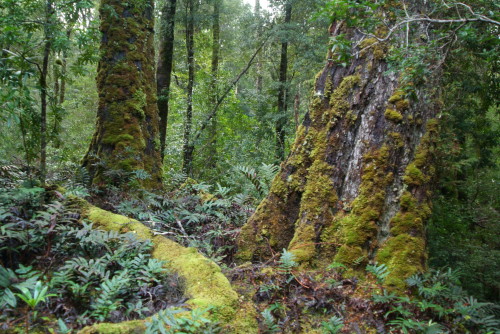
By Seeboundy (Own work) via Wikimedia Commons
South of the Australian mainland lies the island-state of Tasmania; an island recognized for its remarkable natural bounty. Over 40% of the island is currently covered in protected park lands and natural preserves. In the North West corner of Tasmania is a remote area called the Tarkine, named for the Tarkiner Aborigines who once called it home. Within its 447, 000 hectares (about 180,000 acres), the Tarkine contains the largest single tract of undisturbed temperate rainforest in Australia and one of the largest in the world. These old-growth forests have remained virtually undisturbed since the existence of the ancient Gondwana supercontinent and are home to an unknown number of native flora and fauna, such as the Eucalypt forest, and rare animal species, such as the endangered Tasmanian devil.
In 2006 and 2009, T. Thorn Coyle was fortunate enough to visit Tasmania and work with local Forest advocates. In sharing her experience, she remarked:
I’ve been privileged to meditate in the midst of [its] beauty. Tasmania is like no other land I’ve visited. The flora and fauna are unique, and the presence of place is strong. Connecting to the earth there is like connecting to a giant. The whole of the land answers back.
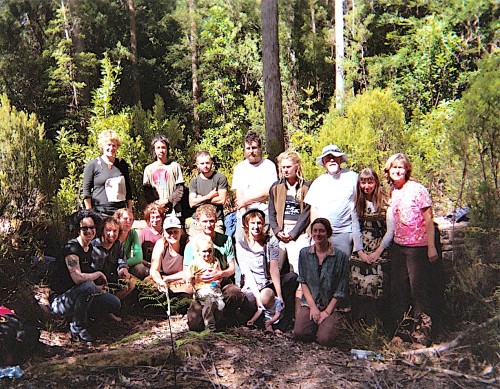
T.Thorn Coyle with Tasmanian Activists in 2006
On its western shores, the Tarkine is home to the relics left by an ancient Aboriginal society that existed in isolation for centuries. The surviving huts and middens, or waste disposal pits, provide a window into the evolution of that culture. Researchers suspect that many more of these relics may be hidden within the Tarkine’s forests. However, just with the known sites, the Australian Heritage Council (AHC), a governmental advisory body, has called the area “one of the world’s great archaeological regions.”
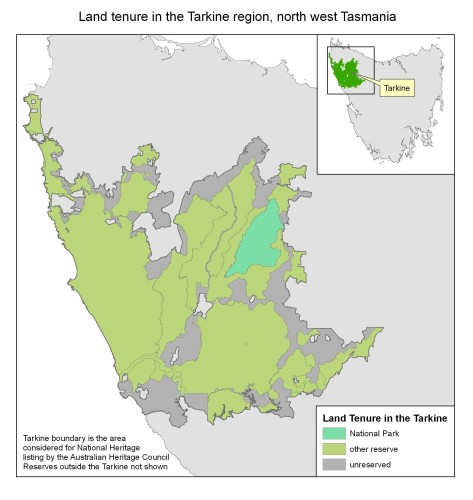
Tarkine of NW Tasmania
By Athrotaxis by Wikimedia Commons
Unfortunately, with all this bounty, the Tarkine has become a battle ground. The land’s richness, that which offers such majesty, also attracts industry. Under current Australian law, the Tarkine Wilderness is not fully protected from development. Only 5% of its 447,000 hectares lay within a National Park. As a result, the area has been the center of an all-too-common struggle that pits human society against the wild.
In 2004, the AHC began a comprehensive study to evaluate whether the Tarkine should be on Australia’s National Heritage List. To be placed on this list, a location must be recognized for “having outstanding cultural or natural value” and, once on, the location is granted preliminary protection. This is the first step to becoming a fully protected National Park. In 2009, the AHC’s review had not yet been complete. However, former Minister of the Environment, Peter Garrett, used an emergency measure to list the Tarkine in order to stop the construction of a potentially invasive road.
Unfortunately, an emergency listing only lasts twelve months. When the year was up, the new Minister of the Environment, Tony Burke, did not renew the listing, but he did ask the AHC continue their evaluation. Finally in January 2013, the Council published its full report, recommending that the entire unprotected 433,000 hectares be placed on the National Heritage List. In brief, the reports states:
The Council found that the rainforests are important for their flora, which has links to the ancient continent of Gondwana, and their lichens and fossils, which help tell the story of Australia’s ancient flora and its evolution. Dotted along the coastline are the remains of numerous hut depressions found in Aboriginal shell middens…the remnants of an unusual and specialized Aboriginal way of life.
One month later, on February 8, Burke announced that the only portion of the Tarkine to be added to the list would be the 21,000 hectares containing the coastal Aboriginal sites – only 4.8% of the Council’s recommendation. Burke added:
I acknowledge that my decision today is not the outcome for the Tarkine that many groups were seeking. I have tried to find a boundary which would incorporate the natural values without delivering unacceptable social and economic outcomes… Tasmania has the highest unemployment rate in Australia…For this reason I have decided to only put the indigenous values on the national heritage list.
This explanation did not satisfy environmental groups. Scott Jordan, Campaign Coordinator for the Tarkine National Coalition said: “This is a massive betrayal of [Tony Burke’s] obligations as the chief protector of Australia’s environment and a gift to the mining corporations who seek to turn the Tarkine into a series of strip mines.” Australia’s Wilderness Society called the act a “spectacular failure.” These two groups, PANGEA (a Pagan Activist Network Group), Get UP and others are continuing their awareness campaigns and organizing protests and petitions with the aim of reversing Burke’s decision.
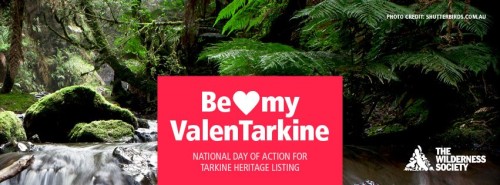
At this point, the biggest threat to the Tarkine is the mining industry. Tasmania’s four top exports are mined minerals accounting for approximately 73% of the state’s export revenue. In December of 2012, Tony Burke approved Shree Minerals’ new Tarkine iron ore mine with a reported 10 more mines planned for the area over the next five years.
Echoing Burke’s economic considerations, Shree Minerals chairman Sanjay Loyalka said:
[The] new mine in North West Tasmania will provide very significant social and economic benefits to the region. We are particularly keen to create employment opportunities for young Tasmanians, to allow them to stay and prosper in their own community…
Not surprisingly, organized labor has joined forces with the mining industry in launching its own Tarkine campaign: Our Tarkine, Our Future. According to those reports, the new Tarkine mines will create 1000s of new needed jobs. Statistically speaking, Tasmanian unemployment did rise from 5% to 7% over the past two years and the state’s average per capita disposable income is 4.4% lower than the national average. But these and other statistics do not tell the story of a desperately struggling economy. Moreover, Tasmanian economist Saul Eslake notes only “a [small] proportion of Tasmania’s economy [as it relates to jobs] is accounted for by the high-productivity mining sector.” If there is a serious labor problem, the new mines may not be the answer.
In the meantime, the struggle continues between industry, government and environmental stewards. From her trips to Tasmania, Thorn noted, “Some [of the] activists were suffering from PTSD from encounters with loggers or police. I offered centering and energy exercises that would help the activists’ work become more sustainable.” These activists and many others will continue fighting to preserve the Tarkine Wilderness aiming ultimately at UNESCO’s World Heritage list and the protection that it brings.
Now, if I may stop being a reporter for a moment to step up on my own soap box. I understand that it can be very difficult to find a positive balance between supporting the human condition, as it stands, and protecting the environment. Uncomfortable choices must often be made. However, no matter the situation, I always find myself at the same point. Environmental conservation is and will always be human conservation. In the full protection of the Tarkine, we are ensuring our continued existence. Right now, the Australian government is borrowing from humanity’s future to presumably fix a present situation. That mode of operation is not sustainable. Without the Tarkine and other similar eco-systems, there can and will be no human society. We must change the paradigm.
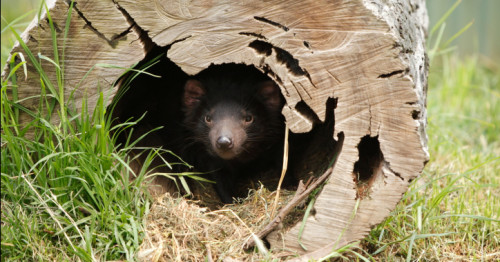
Tasmanian Devil (Photo: Getty Images)
The Wild Hunt is not responsible for links to external content.
To join a conversation on this post:
Visit our The Wild Hunt subreddit! Point your favorite browser to https://www.reddit.com/r/The_Wild_Hunt_News/, then click “JOIN”. Make sure to click the bell, too, to be notified of new articles posted to our subreddit.
As I say elsewhere (repeatedly), there is a serious conflict between economy and ecology at the moment.
The majority of those in positions of power are choosing the wrong one. We can live without a fiscal economy, but we cannot live without a healthy ecosystem.
What is needed is a shift away from an ever expanding, consumerist-driven economic society and an embracing of a more sustainable system of living.
This is not hippy bullshit, but simply logical prudence.
Thank You for this Heather, I often wonder if Pagans, who as a group lean towards holding the earth sacred, are spending enouth time, effort and engaging in activisim in a way that reflects this core value! Great Read
Gondwanaland… Geez, that’s a link to our deep past like no other…
Thanks for posting such an article. As an Australian, a pagan and a student of Cultural Heritage, I have been disgusted with the handling of this by the Minister. It frustrates me that he has the ability to pick and choose which of the crieteria he feels is significant ‘enough’ to warrant protection. These criteria are not graded, they are either ‘yes’ or ‘no’ and much of the time they are linked, with points of significance being relevant to more than one criteria.
There is a Federal Election here in September but I am unsure if a change of government will produce a change in focus towards the Environment….
“Our Tarkine, our future.”
So let’s destroy both????
Tony Burke actually did a great job over the recent addition of many marine parks to our coastline. He bowed down to pressure on this one and I’m sad about that. I will never understand the short term greed of big business. Surely the puppet masters have children too?
Great article voicing the threats to one of the world’s most incredible temperate rainforests. Just a note that only 21% of Tasmania is in secure (ie National Park) reserves, the rest can allow hunting, mining and logging with all but the most basic restrictions.
As Pagans i do believe that we have an obligation for service to the natural world, especially wild places like this. It should be apart of all our core practice. There is much Work to be done and on many levels. Like Joanna Macy points out there is the frontline defence, the work for more sustainable society and the spiritual work of acknowledging our connection to the wild.
For some reason Tasmania seems to struggle to great extent with finding innovative ways of enhancing the economy. Our government here is weak to say the least and extremely unproductive regardless of which major party holds power. Tasmania’s unemployment levels have been the highest in the country for many years including when the forestry industry was thriving. It is high time we gave up exploiting the state to satisfy the wants of the timber and mining industry. The forestry industry made under the table deals with state government during the Bacon/Lennon era and from that they gained a sense of entitlement and fully believe that their industry should be protected as opposed to the areas they destroy in creating profits. Whilst many Tasmanian’s have lost work due a poor economy in this state none of them were presented with the same enthusiasm for protecting their jobs or industry as the forestry sector. The state needs to evolve away from ludicrous options like destroying the Tarkine for a mine or forestry agreement that in just a few short years at most will be abandoned leaving a sacred area destroyed for eternity and to have had no lasting effect on the states economy. The biggest employment issue here is the lack of being able to provide employment stability and longevity and this is because endeavors like mining and logging are not renewable in this state there is not enough resources to move onto another job to give continuum. Mr Burke seems to have it in his head that after the next couple of years that sees the area miked dry it will suddenly spring back up out of the ground and become an ancient rain forest or maybe he can see a future in tourism for those curious of idiotic government and destruction of areas no one human should ever decide the fate of. Come to Tasmania and imagine the beauty we once had.
Not surprisingly, organized labor has joined forces with the mining industry in launching its own Tarkine campaign: Our Tarkine, Our Future. According to those reports, the new Tarkine mines will create 1000s of new needed jobs.
the AWU is traditionally on the right and pro-business wing of the ACTU but has unfortunately also big influence on the Labor party … there is however a different tradition in the Australian labour movement, already in 1970ies, the NSW Builders Labourers Federation (BLF, which also had good positions on international issues and anti-rascism) successfully halted some destructive developments with their Green Bans, unfortunately, the left-leaning NSW BLF was crushed in the mid-seventies by a coalition of employers, the right-wing national leadership of the BLF and some Maoists, more on the NSW BLF here: http://www.internationalviewpoint.org/spip.php?article94